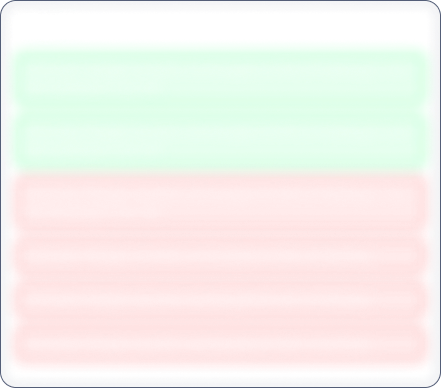Year End Sale 50% off
Airfloa Rail Technology

No Data Available
Investor Sentiment
Airfloa Rail Technology Share price and Fundamental Analysis
Key Metrics
Included In
Stock Returns
Stock Heatmap

No Stocks
Smart Score

Unlock Smart Score
See Detailed Analysis & Insights


Unlock Insights
See Detailed Analysis & Insights
Technicals
Returns Calculator
If you would have investedResearch Report
No Research Report
Corporate Action

No Data Available
Financials
Key Ratios
ROE
Avg ROE (3 Yrs) : NaN%
ROCE
Avg ROCE (3 Yrs) : NaN%
ROA
Avg ROA (3 Yrs) : NaN%
NPM
Avg NPM (3 Yrs) : NaN%
Dividend History
5 Year FactSheet
Documents

No Data Available
News
Airfloa Rail Technology Management and History
Company Management


Unlock Management Data
See Detailed Analysis & Insights
Company History
Airfloa Rail Technology Limited was originally incorporated as Air Flow Equipments (India) Private Limited' a private limited company at Chennai, Tamil Nadu, pursuant to a certificate of incorporation dated December 14, 1998, issued by the Registrar of Companies, Tamil Nadu, Chennai. Thereafter, name of the Company was changed from Air Flow Equipments (India) Private Limited' to Airfloa Rail Technology Private Limited', on August 27, 2024. Thereafter, name of the Company was changed from Airfloa Rail Technology Private Limited' to Airfloa Rail Technology Limited', and a fresh certificate of incorporation to conversion of the company was issued by the Registrar of Companies, Central Processing Centre on November 15, 2024.
The Company is engaged in the manufacturing of components which are used in the rolling stock for the Indian Railways through railway production units like Integral Coach Factory (ICF), other coach factories. In addition to manufacturing the rolling stock components, it carries out turnkey interior furnishing projects for Indian Railways. In the aerospace and defence sectors, it manufactures intricate, highly engineered, and vital components. Along with Indian Railways through ICF and other coach factories, it also serve other Rails factories, and global rolling stock OEMs. It has manufactured rolling stock components and implemented turnkey interior furnishing projects for Sri Lankan DEMU and Mainline Export Coaches, Agra-Kanpur Metro Coach, RRTS Coach, Vistadome Coach and Train-18 Vande Bharat Express.
The Company was the first in India to supply Aluminium with powder coating to railway coaches in 2004. In 2005, it received first export coach windows order for Angola through Indian railways. It provided the own rail coach design to customers in 2008 and ventured into the Metro Rail Division in 2010; further ventured into coach body building in 2016. It started the Aero sapce division in 2019 and acquired the order for complete turnkey interior furnishing of 97 mainline passenger coaches for Sri Lanka through RITES in 2021-23.
Company is planning the initial public offer of 65,07,000 Equity Shares of Rs 10 each through fresh issue.
Airfloa Rail Technology Share Price
Airfloa Rail Technology share price reflects investor sentiment toward the company and is impacted by various factors such as financial performance, market trends, and economic conditions. Share price is an indicator which shows the current value of the company's shares at which buyers or sellers can transact.
Airfloa Rail Technology Market Cap
Market capitalization of Airfloa Rail Technology indicates the total value of its outstanding shares. Marketcap is calculated by multiplying share price and outstanding shares of the company. It is a helpful metric for assessing the company's size and market Valuation. It also helps investors understand how Airfloa Rail Technology is valued compared to its competitors.
Airfloa Rail Technology PE Ratio
Airfloa Rail Technology PE ratio helps investors understand what is the market value of each stock compared to Airfloa Rail Technology 's earnings. A PE ratio higher than the average industry PE could indicate an overvaluation of the stock, whereas a lower PE compared to the average industry PE could indicate an undervaluation.
Airfloa Rail Technology PEG Ratio
The PEG ratio of Airfloa Rail Technology evaluates its PE ratio in relation to its growth rate. A PEG ratio of 1 indicates a fair value, a PEG ratio of less than 1 indicates undervaluation, and a PEG ratio of more than 1 indicates overvaluation.
Airfloa Rail Technology ROE (Return on Equity)
Return on Equity (ROE) measures how effectively Airfloa Rail Technology generates profit from shareholders' equity. A higher ROE of more than 20% indicates better financial performance in terms of profitability.
Airfloa Rail Technology ROCE (Return on Capital Employed)
Return on Capital Employed (ROCE) evaluates the profitability of Airfloa Rail Technology in relation to its capital employed. In simple terms, ROCE provides insight to investors as to how well the company is utilizing the capital deployed. A high ROCE of more than 20% shows that the business is making profitable use of its capital.
Airfloa Rail Technology Total Debt
Total debt of Airfloa Rail Technology shows how much the company owes to either banks or individual creditors. In simple terms, this is the amount the company has to repay. Total debt can be a very useful metric to show the financial health of the company. Total debt more than equity is considered to be a bad sign.
Airfloa Rail Technology Debt to Equity Ratio
The Debt-to-Equity (DE) ratio of Airfloa Rail Technology compares its total debt to shareholders' equity. A higher Debt to Equity ratio could indicate higher financial risk, while a lower ratio suggests that the company is managing its debt efficiently.
Airfloa Rail Technology CAGR (Compound Annual Growth Rate)
CAGR shows the consistent growth rate of Airfloa Rail Technology over a specific period, whether it is over a month, a year, or 10 years. It is a key metric to evaluate the company’s long-term growth potential. Main metrics for which CAGR is calculated are net sales, net profit, operating profit, and stock returns.
Airfloa Rail Technology Technical Analysis
Technical analysis of Airfloa Rail Technology helps investors get an insight into when they can enter or exit the stock. Key components of Airfloa Rail Technology Technical Analysis include:
Support Levels (S1, S2, S3)
There are usually multiple support levels, but the main support levels for a stock are S1, S2, S3. Support levels indicate price points where stock might get support from buyers, helping the stock stop falling and rise.
Resistance Levels (R1, R2, R3)
There are usually multiple resistance levels, but the main resistance levels for a stock are R1, R2, R3. Resistance levels represent price points where Airfloa Rail Technology shares often struggle to rise above due to selling pressure.
Airfloa Rail Technology Dividends
Dividends refer to the portion of the company’s profits distributed to its shareholders. Dividends are typically paid out in cash and reflect Airfloa Rail Technology ’s financial health and profitability.
Airfloa Rail Technology Bonus Shares
Bonus shares are usually given by companies to make the stock more affordable, increase liquidity, boost investor confidence, and more.
Airfloa Rail Technology Stock Split
Stock split increases the number of its outstanding shares by dividing each existing share into multiple shares. When the company offers a stock split, the face value of the stock reduces in the same proportion as the split ratio.
Airfloa Rail Technology Financials
The financials of Airfloa Rail Technology provide a complete view to investors about its net sales, net profit, operating profits, expenses, and overall financial health. Investors can analyze financial data to assess the company’s stability and also understand how the company has been growing financially.
Airfloa Rail Technology Profit and Loss Statements
The profit and loss statement of Airfloa Rail Technology highlights its net sales, net profit, total expenditure, and operating profits in the current financial year. This Profit and Loss statement is crucial for evaluating the profitability and financial stability of Airfloa Rail Technology .
Airfloa Rail Technology Balance Sheet
The balance sheet presents a snapshot of Airfloa Rail Technology ’s assets, liabilities, and equity of shareholders, providing insights into the financials of the company.
Airfloa Rail Technology Cashflow Statements
Cashflow statements track the company's cash inflows and outflows over a period. It is an essential tool for understanding how well the company manages its liquidity and finances.


